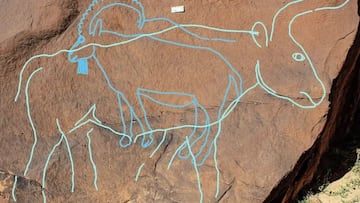Archaeologists make a stunning discovery hidden in the Arabian Desert—what they found could rewrite the history of the driest area on the planet
Ancient life-size carvings, hidden in the desert of Saudi Arabia, are forcing scientists to rethink how early humans lived in the world’s driest region.

One hundred feet above the surface of Saudi Arabia’s vast desert, archaeologists have uncovered an astonishing find—life-size carvings of animals etched into a cliff face thousands of years ago.
The figures, depicting camels and wild horses, are so intricately detailed that researchers say they’ve survived the erosion of time almost untouched. The discovery could transform our understanding of how early human communities thrived in one of Earth’s harshest environments.
62 rock panels, 176 carvings—and a mystery of human ingenuity
According to a new study published in Nature Communications, researchers documented three archaeological sites in the southern Nefud Desert containing 62 engraved rock panels and 176 carvings—130 of them life-sized.
What’s most surprising is where these artists chose to work: precarious cliff faces and hard-to-reach areas that would have demanded both physical skill and remarkable determination.
When the desert was alive
Using luminescence dating—a technique that measures when minerals were last exposed to sunlight—the team determined that this part of the desert once received water between 17,000 and 13,000 years ago.
That brief period of rainfall allowed small groups of humans to settle intermittently. Excavations revealed hearths, stone tools, and an engraved stone buried beneath a sediment layer dating to around 12,800 years ago, confirming the extraordinary age of the artwork.
Traces of the pre-pottery neolithic era
Archaeologists also unearthed more than 1,200 artifacts, including arrowheads, green stone beads, seashells, and mineral pigments. Among them were distinctive El Khiam and Helwan points—hallmarks of the Pre-Pottery Neolithic A period.
These tools show that the main occupation of the site coincides with the earliest stages of the Neolithic according to the study’s authors. This means the region’s ancient inhabitants were far more advanced and culturally complex than previously believed.
Art with purpose: symbolism, ritual, and memory
The research team believes these carvings weren’t mere decoration. Instead, they were monumental expressions of identity and collective memory.
Related stories
Intriguingly, some of the figures are visible only for about ninety minutes each day, when the sunlight strikes the rock at a precise angle—suggesting a deliberate connection to ritual or seasonal cycles.
“These monumental images were used to mark water sources and the routes between them, perhaps providing impressive visual reminders of access rights, while also commemorating these extraordinary desert-adapted groups over millennia,” concluded the authors.
Complete your personal details to comment